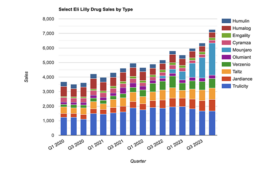
Anick Bérard
Should a woman prescribed antidepressants continue taking them while pregnant? The question is fraught — her health and that of her unborn child is at stake. Yet research to help her and her doctor make that decision is incomplete.
The problem, said epidemiologist Anick Bérard, is that medical researchers must exclude pregnant women from drug trials to protect their babies. Whether it’s antidepressants, antibiotics or anti-migraine medications, “this potentially means that pregnant women have less evidence-based treatment than men and non-pregnant women,” she said. Bérard, a professor in the faculty of pharmacy at the Université de Montréal, aims to change that. She has built a super-database called the Quebec Pregnancy Cohort (QPC) that has already yielded crucial insights into drug use and health outcomes for both mothers and children.
The QPC links four databases containing information on pregnancies of women covered by Quebec’s provincial prescription drug insurance starting in 1997. It represents one-third of women of child-bearing age in the province.
The QPC is one of few such databases, and the only one to contain precise gestational ages. This means researchers can match drug exposures to stages of pregnancy.
“Timing is pivotal,” said Bérard. “Every week of pregnancy produces something different. At six to nine weeks of gestation for example, the heart is formed.”
But the province’s databases were built to help government keep track of payments to doctors and pharmacists, not to analyze drug use outcomes.
And so Bérard and her team have painstakingly validated the data in the QPC. For example, a particular database code may mean a woman was prescribed a drug, but it does not reveal whether she took it. So the team went back to women in the databases to ask if they indeed took the drug, and whether they did so as prescribed.
Codes for birth defects were similarly validated. If it indicated a child was born with a heart defect, researchers crossed-checked with hospital and medical records.
“When we study drugs and the risk of certain birth defects, we know it’s a real risk,” explains Bérard.
In 2005, Health Canada asked her to look into emerging research showing links between pregnant women taking an antidepressant called Paxil and heart defects in their babies.
In 2007, her team published a study based on QPC data showing that Paxil indeed increases the risk of heart defects, helping shape guidelines in Canada and the U.S. on the treatment of depression during pregnancy.
Other users of the QPC have included the U.S. Food and Drug Administration, international universities and pharmaceutical companies.
But long before these groups came knocking, Bérard was renowned for her research into drug use during pregnancy. In 2002, l’Université de Montréal lured her back to her hometown with an offer of a research chair in medications in pregnancy. At the time, she was a professor of epidemiology at the Albert Einstein College of Medicine in New York City, and before that, a research fellow at the Harvard School of Medicine in Boston.
Bérard, 48, is a new recipient of the Canada Foundation for Innovation’s (CFI) John R. Evans Leaders Fund, which she will use to update the QPC beyond its current timeframe of 1997 to 2009.
The award will pay for buying and validating information from provincial databases up to 2014. CFI funds research infrastructure, which often means hardware, but the QPC is a tool like any other: “As an epidemiologist, my machine is my cohort,” said Bérard.
Source: University of Montreal
Filed Under: Drug Discovery




